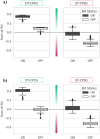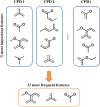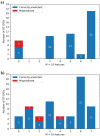Explainable machine learning predictions of dual-target compounds reveal characteristic structural features
- PMID: 34732806
- PMCID: PMC8566526
- DOI: 10.1038/s41598-021-01099-4
Explainable machine learning predictions of dual-target compounds reveal characteristic structural features
Abstract
Compounds with defined multi-target activity play an increasingly important role in drug discovery. Structural features that might be signatures of such compounds have mostly remained elusive thus far. We have explored the potential of explainable machine learning to uncover structural motifs that are characteristic of dual-target compounds. For a pharmacologically relevant target pair-based test system designed for our study, accurate prediction models were derived and the influence of molecular representation features of test compounds was quantified to explain the predictions. The analysis revealed small numbers of specific features whose presence in dual-target and absence in single-target compounds determined accurate predictions. These features formed coherent substructures in dual-target compounds. From computational analysis of specific feature contributions, structural motifs emerged that were confirmed to be signatures of different dual-target activities. Our findings demonstrate the ability of explainable machine learning to bridge between predictions and intuitive chemical analysis and reveal characteristic substructures of dual-target compounds.
© 2021. The Author(s).
Conflict of interest statement
The authors declare no competing interests.
Figures








References
Publication types
LinkOut - more resources
Full Text Sources

